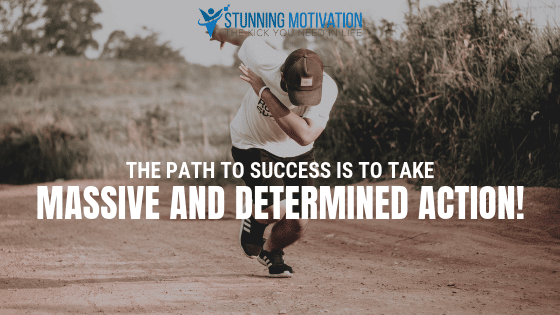In order to be successful, you must acquire the skill of how to turn an idea into reality. That’s what successful people did. They have a dream – an idea of what they want to achieve out of their lives – and then they work relentlessly to turn that idea into their real life.
However, converting an idea from scratch into reality is never an easy job.
Most great ideas remain dormant because people simply don’t have the courage, the resources like time and money to take initiative. In fact, most people are halted by the fear of failure than the excitement of making their ideas a reality.
Regardless of whether you’re an entrepreneur or an employee working in the corporate world, the skill of turning ideas into reality is a powerful one to own.
Glenn Llopis wrote in an article on Forbes that the workforce is not innovative enough because people are trained and wired only to execute on what they are told to do.
To turn an idea into reality, on the other hand, requires creativity, courage, and initiative, which is not what most people are wired to do.
The overall competitive in the marketplace is getting more intense each day. For instance, consider Airbnb, Uber, and Netflix.
These businesses sprung from small ideas, but because the founders take the initiative to nurture the ideas, they grew quickly and became multi-million dollars business empires.
Hence, you must accept and embrace the entrepreneurial spirit if you want to cultivate your ideas and turn them into reality.
We all know that coming up with ideas can be the easy part, what’s difficult is transforming, nurturing, and cultivating the ideas into actions.
And that’s how this article can help you with this. Below are the 7 outstanding steps how you can turn what’s in your mind – your thoughts – into something tangible and make it a success:
1. Write down the ideas and plan
Ideas can come and go quickly, thus, you must write it down whenever you hit the “A-Ha” moment.
Write down the ideas and describe the mental images that flash through your mind. The key here is to create a rough draft of how the ideas look like and so you can create a simple plan of action to make them in reality.
Never underestimate the power of planning. I love this wise saying from Larry Winget:
“Nobody ever wrote down a plan to be broke, fat, lazy, or stupid. Those things are what happen when you don’t have a plan.”
While it is true that having a plan cannot guarantee your success, having no plan is even worse.
At this stage, you don’t have to come up with a detailed and thorough plan of action. You just want to list down your ideas, how they look like, and the rough ideas of how can you make them come true.
2. Stop dreaming and start creating

If you wait for the perfect moment or until you have developed the perfect product, I’m here to tell you to stop dreaming. There is no such a perfect product in this world. You can strive for excellence, but not perfection.
The perfect moment will never come. And you don’t have to wait for things to be perfect to launch.
Never let the thought that your idea or product is not as good on paper or in reality to hold you back from making it happen.
Take a look at the marketplace right now, there are tons of products and services out there. There will always be competition and highly likely, you’re not inventing something new from scratch.
Most successful businesses out there are simply making things better, they are not perfect.
Do you know that Steve Jobs did not invent the phone, but he did make it better.
So stop dreaming and start making things a reality. Some people dream about success, but only those who get up and take action are the ones who can succeed.
3. Start small with the MVP
Next, you want to start small. You want to create a minimum viable product (MVP) to test out the market. If you want to learn more about MVP, I suggest you read the book from Eric Ries, The Lean Startup.
The point is that you don’t want to spend too much time, money, and energy into an idea before you know if it’s working.
Like what Harv Eker explained in his best-selling book, Secrets of The Millionaire Mind. Eker said that when he has the idea to start a café selling pies, he was ecstatic.
Luckily, he knew that starting a café selling pies can cost a lot. And so, he tested out the idea by working in a café that sells pies.
After some time, he learned about the business and he finally came to the conclusion that selling pies was not what he really wanted.
If Eker jumped straight into renting a shop, he would have failed greatly. But he didn’t. He took the MVP approach and learn the business from a competitor.
The same principle can be applied to your ideas. Create your minimum viable product and test out the idea and see how the market responds to it.
4. Invest the amount you can lose
You can use the approach from Jim Collins called “firing bullets before cannonballs”. This is where you invest a little bit of money to test out your idea.
The key is to help you identify and calibrate the idea. Plus, it also helps in finding out if the idea you have is profitable or has any monetary value.
This is what Adam Callinan from BottleCamo said in this article:
“Set aside no more than $200 to test the basic idea. Get a domain and set up a landing page (easier than you think…), then simplify and test your idea with Google Adwords, Bing or Yahoo advertising.
The goal is to see how many people you can get to click your link and at what rate they’re clicking. You can easily and inexpensively determine if there is even a base level need for your new idea.”
Yes, invest a couple of hundreds into the idea and see it sticks.
Remember, you don’t want to overspend your time and money here. Once you have identified a profitable idea and have narrowed down the target market, you can then put in bigger investment and start dominating the niche.
5. Set some progress milestones

By now, you should understand if the idea that you once had is worth pursuing or not. And this is where you leverage goal setting and move things to the next level.
Set clearer goals and come up with a better plan to create a bigger impact in the marketplace. Like what Gary Nelson from The Rox Group said, you have to map out each stage of the process.
You need to set out clear targets and understand what is really going to be required from each department – IT, warehousing, customer service, sales and marketing, purchasing, etc.
If you are having difficulties mapping out the stages of your business or finding it hard to make a plan, read this article from Entrepreneur:
Business Plans: A Step-by-Step Guide
6. Connect the dots
Your initial idea may not be perfect. And this is why you must learn to see the big picture and connect the dots.
Everything is connected to something else. You have to spot the similarities to grow your ideas bigger.
Steve Jobs was a dropped out students. And because of his passion for design, he dropped in for calligraphy classes. Although he has no idea how calligraphy can be practical in his life, he just trusted his instinct.
After Jobs founded and created the Mac, only then he realized that his knowledge in calligraphy has helped him in creating beautiful typefaces in Apple.
Sometimes, you will never know how your initial idea will turn out and transform you. You just need to believe in it and always look at the big picture.
Like how Airbnb started. Two young men, Brian Chesky, and Joe Gebbia just moved to New York and they were having trouble to pay their rent. They were always on the look for opportunities to earn extra money.
One day, they wanted to attend a design conference at San Francisco but the hotels in the city were fully booked. So they came out with the idea of renting out 3 airbeds on their living room floor and cooking breakfast for their guests.
The next day, they created a website called “airbedandbreakfast.com”, and 6 days later, they had their first guest. And the rest, they say, is history.
You will never know how your ideas will turn out. Follow your heart and always connect the dots by looking at the bigger view on things.
7. Get feedback, review, and decide the next step
By now, you should have started and produced some results. And this is the time for you to do a post-mortem on your ideas and progress.
Do you want to expand and bring your ideas to a higher level? Or do you think that you should scrap the idea because it is not something that you are looking for?
If you choose to go big, great, always challenge yourself and make your ideas better. Tony Robbins called this “CANI”, or constant-and-never-ending-improvement. The Japanese have a name for it – kaizen.
Once you have decided to take your idea to a higher level, you have to embark on the journey for continuous improvement. You have to treat your results as feedback so that you can learn and improve to become better.
Do understand that every big success started small. Every master was once a beginner. And every big business started off as an idea.
And to turn your ideas into reality, you must learn and improve along the way.
Another good way to improve is to get feedback from the public. Ask other people, check out with your customers, and get the reviews from your clients. They will tell you where to improve.
Conclusion
Turning your ideas from nothing into reality is challenging. But with the help of the 7 steps above, you can have a clearer view of how things can work out for you.
Now, allow me to share with you the most difficult part of turning your ideas into reality – the wait.
Yes, it will take time, a long time in fact. Your ideas will not turn into a billion-dollar business overnight. Everything takes time.
And this is where most people fail because they choose to give up on their ideas. Learn from the bamboo trees and understand that the effort and energy you put in are to build a stronger foundation for your ideas.
Have patience, my friend.
Rome was not built in a day. And Warren Buffett did not become a billionaire investor overnight. Hence, be patience, and strive for improvement until your ideas become a reality.


